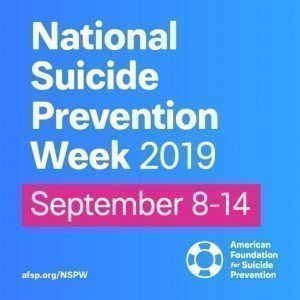According the Centers for Disease Control and Prevention, suicide is the 10th leading cause of death for Americans overall and the second leading cause of death among young people aged 10–34. Almost 10 million adults self-report serious thoughts of suicide.
The scope and scale of the problem are evident. Suicide, suicide attempts, and suicidal thoughts are a serious health concern, but we want to live in the solution, not the problem, and the hopeful news is there are many resources available to help you if you are having suicidal thoughts, and for loved ones who want to help. Suicide IS preventable, but only if we talk openly and honestly about the problem, and get informed so we can be helpful and prepared.
Important note: this article is for informational purposes only. If you or a loved one are in immediate crisis, call the National Suicide Prevention Line at 1-800-273-TALK (8255) or the National Hopeline Network at 1-800-SUICIDE (1-800-784-2433).

Know the Warning Signs
Understanding the issues concerning suicide and mental health are vital to be an active participant in suicide prevention, help others in crisis, and change the conversation around suicide.
If you are concerned a loved one is in danger of suicide it can be a helpless feeling, but there are many resources available to help. The first step is to know the warning signs. It’s particularly important to pay attention to these signs if the behavior is new, has increased, or seems related to a painful event, loss, or change. According to the Suicide Prevention Lifeline, these are the most common signs to look out for:
- Talking about wanting to die or to kill themselves
- Looking for a way to kill themselves, like searching online or buying a gun
- Talking about feeling hopeless or having no reason to live
- Talking about feeling trapped or in unbearable pain
- Talking about being a burden to others
- Increasing the use of alcohol or drugs
- Acting anxious or agitated; behaving recklessly
- Sleeping too little or too much
- Withdrawing or isolating themselves
- Showing rage or talking about seeking revenge
- Extreme mood swings
In addition to understanding specific warning signs, educate yourself on risk factors for suicide. People with mental health disorders such as mood disorders, anxiety, depression, and schizophrenia are at risk, as well as people with a family history of suicide, a history of trauma and/or abuse, and who have experienced a recent change in their life circumstances such as loss of a loved one, job, or other financial loss. Geographic areas that have experienced a ‘cluster’ of suicides also puts people at risk, as well as people who feel a lack of social support and/or poor access to healthcare.

How You Can Help Someone in Crisis
When someone is in crisis, it’s important to know what is most helpful as well-intentioned advice can be more harmful than helpful. The organization “BeThe1To” has outlined 5 helpful steps for responding to someone in crisis, and these steps are frequently used by Suicide Help Lines as well. In order to be prepared, familiarize yourself with these steps and make note of them so you don’t have to think in a crisis, just react. In addition to contacting a suicide helpline, take the following five steps for communicating with someone in crisis:
Ask and Listen: It can be scary to do, but it’s important not to hold back asking the question “Are you thinking about suicide?” to someone in crisis. It’s equally important to ask this in a supportive, non-judgmental, and unbiased way, in order to encourage someone to open up and establish a dialogue with you. Do not ever promise to keep their thoughts of suicide a secret. Listen to their answers, and don’t minimize and/or invalidate their feelings. Talk about their feelings and their reasons, as opposed to telling them your thoughts and feelings. Studies show that asking at-risk individuals if they are suicidal does not increase suicides or suicidal thoughts. In fact, studies suggest the opposite: findings suggest that acknowledging and talking about suicide helps to reduce suicidal ideation.
Keep them Safe: Find out what you can to establish immediate safety. Ask whether they have already had an attempt, if they have a specific plan in place, and determine external danger to being able to execute that plan (for examples, if there are medications and/or weapons they can easily access). The more steps and pieces of a plan that are in place, the higher their severity of risk and their capability to enact their plan might be. Extra steps (like calling the authorities or driving them to an emergency department) might be necessary. A Suicide Help Line is always an important resource during these moments if you aren’t entirely sure what to do next. The myth “If someone really wants to commit suicdie, they’ll find a way to do it” often does not hold true if appropriate safety measures are put into place.
Be Present: This could mean being physically present for someone, speaking with them on the phone, or any other way that shows support for the person at risk. It’s important to be able to follow through with the ways in which you say you’ll be able to support the person – do not commit to anything you are not willing or able to accomplish. If you are unable to be physically present with someone with thoughts of suicide, talk with them to develop some ideas for others who might be able to help as well (again, only others who are willing, able, and appropriate to be there). Increasing connection to others and limiting isolation (both in the short and long-term) has shown to be a protective factor against suicide.
Help Them Connect: Helping someone with thoughts of suicide connect with ongoing support like a Suicide Help Line can help them establish a safety net for moments they find themselves in a crisis. Additional components of a safety net could include connecting them with support and resources in their community, like a mental health professional or other local resource. Help establish a safety plan that includes ways for them identify if they start to experience significant, severe thoughts of suicide along with what to do in those crisis moments. A safety plan can also include a list of individuals to contact when a crisis occurs.

Research by the National Institute of Health has demonstrated that individuals who called a Suicide Help Line were significantly more likely to feel less depressed, less suicidal, less overwhelmed, and more hopeful by the end of calls handled by Applied Suicide Intervention Skills trained counselors.
Follow-Up: After the initial crisis has passed, and after you’ve connected them with the immediate support systems they need, make sure to follow-up with them to see how they’re doing. Leave a message, send a text, or give them a call. The follow-up step is a great time to check in with them to see if there is more you are capable of helping with, and let them know you are there for them. This increases feelings of connectedness, and lets them know they are not alone.
Get Help for Yourself
If you are dealing with suicidal thoughts, remember that you are NOT alone, and that millions of people have had suicidal thoughts at some point in their lives. Feeling suicidal is not a weakness, flaw, or character defect, it only means that you have more pain than you can cope with right now and that you need (and deserve) help and resources. In the midst of strong suicidal thoughts and/or ideation, there are steps you can take immediately to get and receive help;
The most important thing you can do is ask for help. Call a Suicide Help Line, like the National Suicide Prevention Lifeline at 1-800-273-TALK (8255), the National Hopeline Network at 1-800-SUICIDE (1-800-784-2433), or the Veterans’ Crisis Line at 1-800-273-TALK (8255), then press 1. Sometimes opening up to a loved one or friend can feel more difficult than calling someone you don’t know, and these are trained professionals who know what to do and can offer immediate assistance. Here are some important things to consider when you ask for help:
- Tell the person exactly what you are telling yourself. If you have a suicide plan, explain it to them.
- Phrases such as, ‘I can’t take it anymore’ or ‘I’m done’ are vague and do not illustrate how serious things really are. Tell the person you trust that you are thinking about suicide.
- If it is too difficult for you to talk about, try writing it down and handing a note to the person you trust. Or send them an email or text and sit with them while they read it.
Raise Awareness of Suicide Prevention
Something we can all participate in is helping to raise awareness of suicide and suicide prevention. Many people are reluctant to ask for help due to a perceived stigma surrounding suicide, and the more openly and honestly we talk about suicide the more it help people understand they are not alone and that help is available. Share stories of hope and recovery online, and help spread the word that suicide is preventable and that you are there to help.
It is becoming more frequent for people who are struggling with suicidal thoughts turn to social media, and it is increasingly common for friends and loved ones to become concerned due to social media posts. For over 10 years, the National Suicide Prevention Lifeline has worked with social media platforms and digital communities to establish recommended best practices in suicide prevention for social and digital media. Learn more about social media and suicide risk by going to the Suicide Prevention Lifeline’s Social Media Information page, and/or download this helpful guide for Support for Suicidal Individuals on Digital and Social Media.
By working together we can ALL be part of the solution and save lives.





